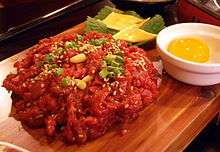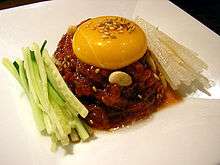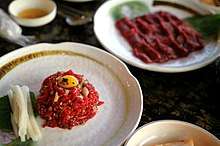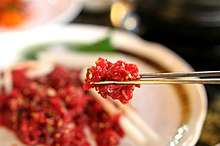Yukhoe
Yukhoe (Korean: 육회 [jukʰø]) is a raw meat dish in Korean cuisine that resembles a steak tartare. It is most commonly made of beef but it can come in various kinds and cuts of meat.
| Yukhoe | |
 Yukhoe served with separate egg yolk | |
| Korean name | |
|---|---|
| Hangul | |
| Hanja | |
| Revised Romanization | Yukhoe |
| McCune–Reischauer | Yukhoe |
Yukhoe literally means 'raw (hoe, 膾) meat (yuk, 肉)'. Therefore, in the strictest context, the term designates any dish of raw meat cut up for consumption without the marinade. But colloquially yukhoe means a dish of marinated raw beef slices as shown in the photo. Though relatively rare to find these days, yukhoe can come in all kinds of meat. Yukhoe made of other meats will mention the source of the meat, for instance, a kkwong-yukhoe is made of pheasant, and a mal-yukhoe is made of horse meat.
Yukhoe is most commonly made of lean cuts such as an eye of round, but more tender cuts of a beef can also be used. The beef is cut into thin strips while removing the fat, then it is seasoned with salt, sugar, sesame oil, pepper, and garlic.[1] Korean pear, raw egg yolk, and pine nuts are commonly used as garnishes.
Yukhoe is also made with other cuts of beef, such as liver, kidney, heart, cheonyeop, or yang, in which case the dish is called gaphoe (Hangul: 갑회, hanja: 甲膾). The ingredients are thoroughly cleaned and salted, then rinsed and dried to remove unpleasant odors. Gaphoe is usually seasoned with sesame oil, salt and pepper, and is served with a spicy mustard sauce.[2]
History

According to the 19th century cookbook Siuijeonseo (시의전서, 是議全書), thin slices of tender beef are soaked to remove blood before being finely shredded. The shredded beef is then marinated in a mixed sauce of chopped spring onion, minced garlic, pepper, oil, honey, pine nuts, sesame, and salt. Its dipping sauce, chogochujang (초고추장), chili pepper condiment mixed with vinegar and sugar) can be altered to taste, with pepper or honey.[3]
Varieties
Beefs
- Cheonyeop-hoe (처녑회) – omasum
- Deunggol-hoe (등골회) – spinal cord
- Dugol-hoe (두골회) – brain
- Ganhoe (간회) – liver
- Gaphoe (갑회) – liver, kidney, omasum, abomasum
- Japhoe (잡회) – liver, tripe, kidney, and lean meat
- Kongpat-hoe (콩팥회) – kidney
- Satae-hoe (사태회) – shank
- Soesim-hoe (쇠심회) – tendon
- Yanggan-hoe (양간회) – tripe and liver
- Yanghoe (양회) – tripe
- Yukhoe (육회) – lean meat
Health concerns
Meat in Korean cuisine has highly detailed classifications regarding freshness, quality, and part differentiation for specific cooking methods.[4] Since yukhoe uses raw beef, freshness is the most important criterion, and for this typical dish's beef it is recommended to use no more than one day after defrosting, and traditionally should not be aged more than one day after slaughtering. Regular Korean yukhoe customers are often patrons of trusted restaurants or butcher's shops which have well-known, high-quality beef distributors.[5][6][7]
Since 2004, the Korean Government has run the Beef Traceability System.[8] This system requires ID numbers with the age of the beef animal of origin, supplier, distributor, the beef's grade, and butchering date and originating butchery. Most of the good beef restaurants in Korea list their beef's information on the wall. Also, butcher shops post signs saying, "new beef coming day" (소 들어오는 날 so deureoyoneun nal): these words have become a well-known idiom in Korea.[9] and it means newly butchered beef supplied at the day.
Raw beef can be contaminated with pathogenic bacteria, with enterohemorrhagic E. coli (O111 or O157:H7) being of particular concern. But only by freshness of beef, the risk can be reduced.[10]
Japan 2011 incident
In April and May 2011, five people died and more than 35 people were hospitalised after eating yukke (Japanese spelling)[11] made from beef not designated for raw consumption in various branches of a bulgogi restaurant chain in Toyama and Kanagawa prefectures, Japan, with enterohemorrhagic E. coli bacteria found in many of the cases.[12][13][14]
As a result, the Japanese Ministry of Health, Labor and Welfare (MHLW) has developed new regulations[15] to require cooking the surface 1 cm deep to further reduce contamination.
On October 22, the last hospitalized 14 year boy died of hemolytic-uremic syndrome. The total death toll of this incident became five people.[16] The MHLW developed regulations for trimming raw beef[17] to remove surface contamination.
Gallery


 Malgogi-yukhoe (horse meat tartare)
Malgogi-yukhoe (horse meat tartare) Malgogi-yukhoe (horse meat tartare)
Malgogi-yukhoe (horse meat tartare)
References
- (in Korean) Yukhoe at Doosan Encyclopedia.
- (in Korean) Gaphoe at Doosan Encyclopedia.
- (in Korean)Yukhoe Archived June 10, 2011, at the Wayback Machine at Korea Britannica.
- (korean) Cooking of meats in Korean cuisine at Doosan Encyclopedia.
- KAPE.
- HACCP
- "Yukhoe : Steak tartare in Visit Seoul". Archived from the original on 2012-04-26. Retrieved 2011-05-10.
- https://web.archive.org/web/20090220203853/http://www.mtrace.go.kr/
- "New Korean beef coming day" Launched by GS shop. (in Korean)
- http://whqlibdoc.who.int/publications/2009/9789241547895_eng.pdf
- Asahi Shimbun "2nd E. coli death linked to popular barbecue chain", Asahi Shimbun, May 3, 2011, accessed May 9, 2011.
- Kyodo "Death toll in food poisoning at 'yakiniku' chain reaches 4", Japan Times, May 6, 2011, accessed May 6, 2011.
- Kyodo "Police launch raids over fatal 'yakiniku' poisonings" Archived May 9, 2011, at the Wayback Machine, Japan Times, May 6, 2011, accessed May 6, 2011.
- "Concerns, Questions Mount in Fatal Raw Beef Case". The Wall Street Journal. May 6, 2011.
- http://www.yomiuri.co.jp/dy/national/T111002002604.htm Accessed 10/04/11
- "ユッケ食中毒5人目死亡 (Yukhoe food poisoning killed five people.)" (in Japanese). Asahi.com. October 24, 2011. Archived from the original on October 26, 2011."ユッケ食中毒5人目死亡 (Yukhoe food poisoning killed five people.)" (in Japanese). Asahi.com. October 24, 2011. Archived from the original on October 24, 2011. (Archived by WebCitation)
- http://search.japantimes.co.jp/cgi-bin/ed20110516a1.html Accessed 10/04/11
External links
| Wikimedia Commons has media related to Yukhoe. |
- (in Korean) Recipe for yukhoe at Daum
- Recipe for yukhoe at Chow.com
- Mangchi's Recipe of yukhoe Korean style tartare at Maangchi.com
- Recipe for yukhoe at Souschef.co.uk